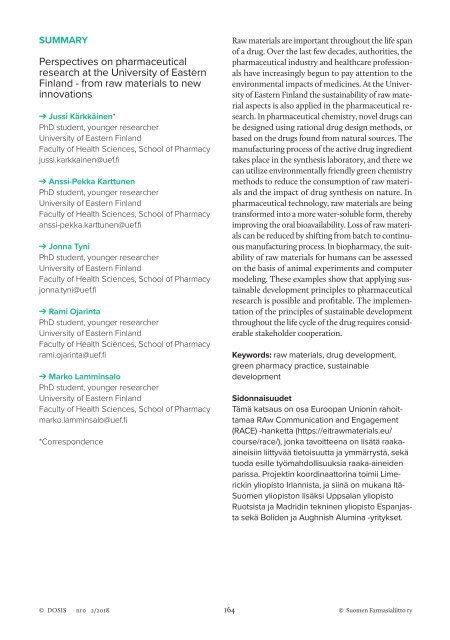DOSIS 2/2018
Farmaseuttinen aikakauskirja DOSIS 2/2018 vol.43 Suomen Farmasialiitto ry
Farmaseuttinen aikakauskirja DOSIS 2/2018 vol.43 Suomen Farmasialiitto ry
You also want an ePaper? Increase the reach of your titles
YUMPU automatically turns print PDFs into web optimized ePapers that Google loves.
SUMMARY<br />
Perspectives on pharmaceutical<br />
research at the University of Eastern<br />
Finland - from raw materials to new<br />
innovations<br />
➔ Jussi Kärkkäinen*<br />
PhD student, younger researcher<br />
University of Eastern Finland<br />
Faculty of Health Sciences, School of Pharmacy<br />
jussi.karkkainen@uef.fi<br />
➔ Anssi-Pekka Karttunen<br />
PhD student, younger researcher<br />
University of Eastern Finland<br />
Faculty of Health Sciences, School of Pharmacy<br />
anssi-pekka.karttunen@uef.fi<br />
➔ Jonna Tyni<br />
PhD student, younger researcher<br />
University of Eastern Finland<br />
Faculty of Health Sciences, School of Pharmacy<br />
jonna.tyni@uef.fi<br />
➔ Rami Ojarinta<br />
PhD student, younger researcher<br />
University of Eastern Finland<br />
Faculty of Health Sciences, School of Pharmacy<br />
rami.ojarinta@uef.fi<br />
➔ Marko Lamminsalo<br />
PhD student, younger researcher<br />
University of Eastern Finland<br />
Faculty of Health Sciences, School of Pharmacy<br />
marko.lamminsalo@uef.fi<br />
*Correspondence<br />
Raw materials are important throughout the life span<br />
of a drug. Over the last few decades, authorities, the<br />
pharmaceutical industry and healthcare professionals<br />
have increasingly begun to pay attention to the<br />
environmental impacts of medicines. At the University<br />
of Eastern Finland the sustainability of raw material<br />
aspects is also applied in the pharmaceutical research.<br />
In pharmaceutical chemistry, novel drugs can<br />
be designed using rational drug design methods, or<br />
based on the drugs found from natural sources. The<br />
manufacturing process of the active drug ingredient<br />
takes place in the synthesis laboratory, and there we<br />
can utilize environmentally friendly green chemistry<br />
methods to reduce the consumption of raw materials<br />
and the impact of drug synthesis on nature. In<br />
pharmaceutical technology, raw materials are being<br />
transformed into a more water-soluble form, thereby<br />
improving the oral bioavailability. Loss of raw materials<br />
can be reduced by shifting from batch to continuous<br />
manufacturing process. In biopharmacy, the suitability<br />
of raw materials for humans can be assessed<br />
on the basis of animal experiments and computer<br />
modeling. These examples show that applying sustainable<br />
development principles to pharmaceutical<br />
research is possible and profitable. The implementation<br />
of the principles of sustainable development<br />
throughout the life cycle of the drug requires considerable<br />
stakeholder cooperation.<br />
Keywords: raw materials, drug development,<br />
green pharmacy practice, sustainable<br />
development<br />
Sidonnaisuudet<br />
Tämä katsaus on osa Euroopan Unionin rahoittamaa<br />
RAw Communication and Engagement<br />
(RACE) -hanketta (https://eitrawmaterials.eu/<br />
course/race/), jonka tavoitteena on lisätä raakaaineisiin<br />
liittyvää tietoisuutta ja ymmärrystä, sekä<br />
tuoda esille työmahdollisuuksia raaka-aineiden<br />
parissa. Projektin koordinaattorina toimii Limerickin<br />
yliopisto Irlannista, ja siinä on mukana Itä-<br />
Suomen yliopiston lisäksi Uppsalan yliopisto<br />
Ruotsista ja Madridin tekninen yliopisto Espanjasta<br />
sekä Boliden ja Aughnish Alumina -yritykset.<br />
© <strong>DOSIS</strong> nr0 2/<strong>2018</strong> 164<br />
© Suomen Farmasialiitto ry

















